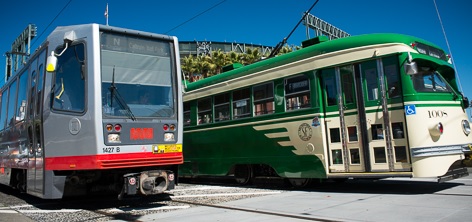Felix Castillo stood in the early morning cold just south of San Francisco’s Dogpatch neighborhood on Cesar Chavez Street. Before him were rows of busses parked end to end in the Islais Creek Division Yard. Instead of his usual grey Muni uniform, the 34-year-old wore a white full body personal protection suit originally designed to keep out lead and asbestos.
Today the suit is a barrier from a virus.

After fitting a N-95 mask to his face, Castillo boarded the unusual bus with bright white paint and blue emblems displaying the universal symbol for medicine, a snake wrapped around a staff. A plastic screen ran from side to side and floor to ceiling, separating the driver’s seat in a plastic bubble. His supervisors at the San Francisco Municipal Transportation Agency said the 40-foot bus would only transport eight passengers, two medical professionals and six houseless individuals suspected of contracting COVID.
Castillo was one of the handful of drivers who volunteered to operate the San Francisco Fire Department’s ambulance bus, a vehicle designed to transport victims from an event with mass casualties.
“My friends thought I was crazy. But I was like, ‘Nah, I’m better off than you guys,’” Castillo said. “I had a full body suit, a mask and plastic dividers. Some of the regular drivers only were given two N-95 masks a week.”
The drivers who volunteered to run the ambulance bus did so when the risk of transmission of the virus was still poorly understood. Surface transmission was still a major concern. Showing up for duty, despite all the unknowns, was another way drivers demonstrated what it means to be called an “essential worker.”
But that role extends beyond those who worked in a medical capacity. Drivers continued operating vehicles as frontline essential workers, taking other essential workers to their jobs at hospitals, grocers, and restaurants.
Now, more than a year after the shelter-in-place public health order, routes remain on hold and drivers have been assigned to other duties. Even with the city well on its way to wide adoption of the vaccine, their job security remains in jeopardy, interviews with Muni operators, transit advocates and union leaders reveal.
The pandemic thrust San Francisco’s understaffed transit operator workforce into a tailspin. Going into 2019 the 6,000 plus labor force had 800 vacancies and was already 17 percent below the number of operators needed to provide full service, according to Julie Kirschbaum, SFMTA director of transit.
Despite federal aid staving off layoffs due to the loss of revenue throughout the shut-down, which had been estimated to be as high as 20 percent of the labor force, Muni continues to be financially unsustainable. Ridership, a major revenue source, sits at historic lows: 70 percent down when compared to pre-pandemic numbers, which compounds the pre-existing and ballooning structural deficit.
The Early Days
In March 2020, transit operators were among the few essential workers still roaming the city streets.
“It was some of the easiest routes I’ve ever run: the streets were empty. It was eerie, but nice to have the roads to yourself,” operator Brendan Bartholomew, 51, said.
Busses were running faster at first, according to data from the SFMTA, and some routes saw time reductions of up to 50 percent. However, the ease of driving empty roads did little to make up for the disruption and uncertainty that marked the early days of the pandemic.
“I wasn’t sure if my bus had enough ventilation, even with the windows open,” Bartholomew said. “Guidelines from the CDC were so unclear on how it applied to us on the bus.”
The SFMTA faced a staffing shortage, even as bus routes were suspended. Agency executives instituted a hiring freeze last year and reassigned some operators as bus cleaners, mask baggers and transit ambassadors.
Bartholomew said he was especially concerned about risking exposure to COVID because he also worked as a live-in caretaker for his mother — A fact that he never forgot when he found himself in conflict with passengers that refused to wear masks.
Although ridership went down, confrontations with passengers due to their refusal to properly wear a mask went up. Castillo recalled that his cousin, who also works as a driver for the SFMTA, was spit on by a passenger who refused to wear a mask.
“He called me and asked me, ‘What do I do now?’” Castillo said. “I didn’t know what to tell him. Should we call an ambulance? How dangerous is it for someone to spit on you? We didn’t call the police — it’s San Francisco — it’s hard to chase someone down who just spit on you.”
The abuse from those that refused to comply with the mask regulations didn’t stop at the operators. Fellow passengers also dealt with the impact.
In another incident, Castillo said he was forced to stop his bus because a drunk passenger refused to wear a mask. This time the police were called, but it took them more than an hour to arrive. Castillo’s bus was removed from service, creating delays for passengers on the bus and those awaiting its arrival.
“Sometimes it feels like I’m negotiating for my life, but it’s not me who I’m fighting for, I’m fighting for everyone’s safety,” Bartholomew said.
Passengers who refuse to follow public health protocols not only pose a risk to operators, but also cause delays in service – which pose a unique danger to a public transit system in a fragile state of recovery.
Transit Death Spiral
The SFMTA’s financial deficit predates the pandemic, jeopardizing jobs and a critical public service already on a steep climb to recovery.
Reliability is crucial to bringing the Muni back to the levels of service and operation that were in place before the pandemic, according to Mark Cordes, executive director of the San Francisco Transit Riders, a nonprofit organization dedicated to improving the city’s public transit service. To illustrate his point, Cordes refers to a transportation industry term, the “transit death spiral.”
“The more unstable a system becomes, the more unreliable it becomes for whatever reason, the less I can depend on it to get to my job [and] the more I’ll look for other modes of transportation,” Cordes said. “And that can begin a ridership decline that can be very difficult to arrest.”
The transit death spiral is a vicious cycle, where buses are now stuck behind the increased traffic of personal vehicles, many of which are driven by former transit riders. According to data from the San Francisco County Transportation Authority by March of this year traffic had already returned to 85 percent of the pre-pandemic levels, despite the city remaining in partial shut-down. Their traffic planners warn that congestion could exceed pre-pandemic numbers if public transit use does not ramp up.
Ridership fares represent a significant part of Muni’s revenue, and the decrease in ridership poses a threat to a system already burdened by a growing deficit.
Congress approved a $975 million coronavirus relief bill, and that’s prevented the agency from laying off as many as 22 percent of its staff. However, operating expenses and capital projects are currently running a budget deficit that is projected to reach $35.9 billion by 2050, according to the SFMTA. The agency will need to secure a sustainable source of long-term funding to maintain even the current service and begin restoring them to pre-pandemic levels.
Part of the solution to increasing service and reliability is pushing the agency to get more vehicles running routes, according to Roger Marenco, president of the Transportation Workers Union Local 250A.
“There is a shortage of vehicles,” Marenco said. “We have the operators — we have the men and women ready to go — ready to operate these vehicles, but as you guys already know, the cable cars are out of service, the historic street cars and the light rail vehicles are out of service. So what we have is a shortage of vehicles because they are parked at the bus station.”
Many drivers who were assigned to new roles related to the pandemic have returned to driving buses. But many remain in roles they were not initially hired to do.
Running more vehicles on routes post-pandemic is much harder to do.
“We have safety requirements that constrain the system and the service we put out, including no in-field operator reliefs due to the need to re-sanitize the vehicles after an operator uses it back at the bus yard,” SFMTA spokesperson Erica Kato said.
Solutions
The pre-existing labor shortage, unmitigated structural deficit and the drop in ridership caused by the shelter-in-place public health order poses serious questions about Muni’s future.
Public engagement, to date, has been an effective way to tackle some of these issues.
For instance, the K-Ingleside light rail line is proof that advocacy works. Initially slated to return next year, neighborhood merchants brought their complaints to Supervisor Myrna Melgar, who then worked with Mayor London Breed to bring back service. It was restored on May 15 alongside Muni’s reopening of their metro subway stations.
“Our organization is premised on the idea that amongst the most significant and impactful players in this system are the people of the city and county of San Francisco,” Cordes said.
The federal relief money was not just given to the city, according to Cordes. It was the result of advocacy and work from his organization that brought the collective voices of riders forward to key senators and legislators.
Marenco advocates for riders to report those conditions to the city’s 311 customer service center. The reports help to document the areas that require more service and make it easier for groups like the SFTR to advocate for more resources.
As for transit operators, they say the public has made their interactions with uncooperative passengers easier and safer.
Castillo is now running his routes full time, something he wants all drivers to get back to doing soon. However, now when he enforces the mask-wearing rule it is common for passengers to come up and thank him.
“When they thank me for doing that or for my service, now it feels like they know what we’re going through,” Castillo said.
This piece was produced by City College of San Francisco Journalism Department and the Democracy and Informed Citizen Emerging Journalist Fellowship initiative of California Humanities.




